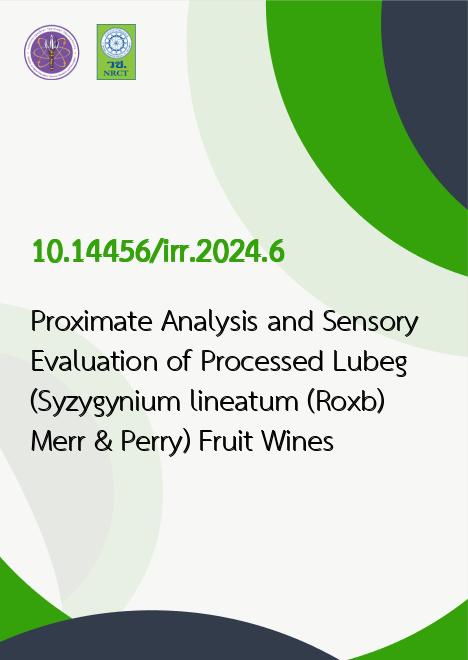
|
Proximate Analysis and Sensory Evaluation of Processed Lubeg (Syzygynium lineatum (Roxb.) Merr. & Perry) Fruit Wines |
|---|---|
| รหัสดีโอไอ | |
| Creator | Aisie O. Bete- Liban |
| Title | Proximate Analysis and Sensory Evaluation of Processed Lubeg (Syzygynium lineatum (Roxb.) Merr. & Perry) Fruit Wines |
| Publisher | Phetchaburi Rajabhat University |
| Publication Year | 2567 |
| Journal Title | Interdisciplinary Research Review (IRR) |
| Journal Vol. | 19 |
| Journal No. | 5 |
| Page no. | 11-19 |
| Keyword | Lubeg wines, proximate analysis, alcohol content, sensory evaluation |
| URL Website | https://ph02.tci-thaijo.org/index.php/jtir |
| Website title | Interdisciplinary Research Review (IRR) |
| ISSN | 2697-536X |
| Abstract | Lubeg tree thrives in tropical climatic conditions, such as in the northern part of the Philippines. Lubeg fruit is characterized as highly perishable and has a sour taste, hence, many fruits were wasted during its peak season. Developing and processing the fruits is considered to maximize the full potential of Lubeg fruits. With this, the study sought to enhance the quality of the developed three Lubeg wines through determining the proximate analysis and sensory evaluation. The Lubeg wines differ in sweeteners being added. The first sample is Lubeg wine with sugar; the second sample is wine with honey; and the third sample has wine with both honey and sugar. Based on the result, the proximate analysis of the Lubeg wine products shows moisture content ranging from 92.86% to 98.54%, ash (0.03%–0.04%), calories (78 kcal–112 kcal), carbohydrates (2 g–10.80 g), and sugar (10.50 g–2.00 g). The total fat of 1% is present in sample 2. The alcohol content of the wine samples ranged from 5.92%- 9.17% and was categorized as low-alcohol fruit wine. In terms of sensory evaluation, there was no significant difference between the appearances of the three Lubeg wine samples. However, there were substantial moderate differences between the ratings of the samples for aroma, taste/texture, aftertaste, and overall impression and there was a significant large difference in their totality. Sample 1 consistently received higher ratings for aroma, taste/texture, aftertaste, overall impression, and totality compared to Sample 2. Sample 3 was not significantly different from Sample 1 in all the dimensions, except for taste/texture. All the Lubeg wine samples were accepted by the respondents, but Sample 1 is the most likable among the three samples. The return above the variable cost (12.96% to 20.45%) of the Lubeg wine samples can be a viable income-generating activity. Further studies on the fermentation process of the Lubeg fruit wines, the determination of other parameters of proximate analysis, and other laboratory activities should be conducted to have comprehensive data on the health benefits, vitamins, and mineral components of the produced Lubeg fruit wines. |